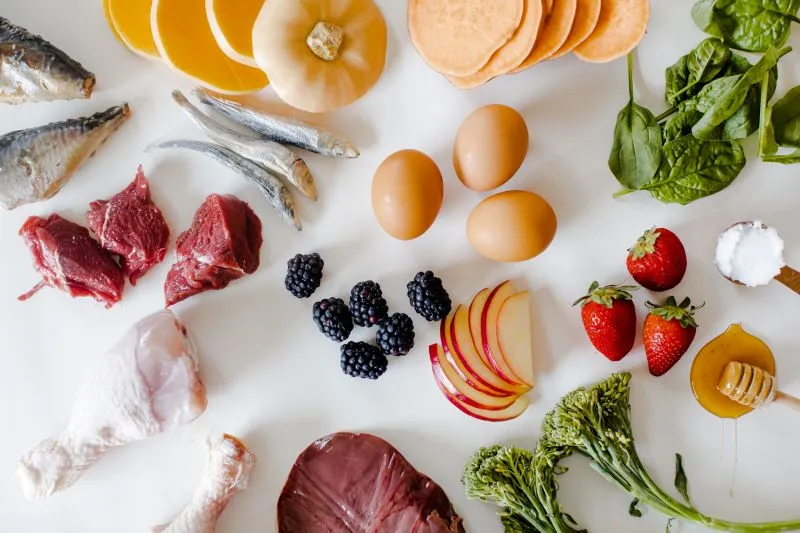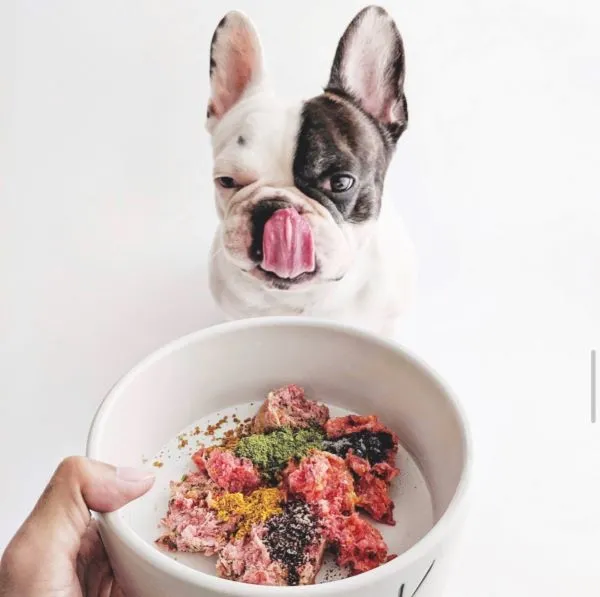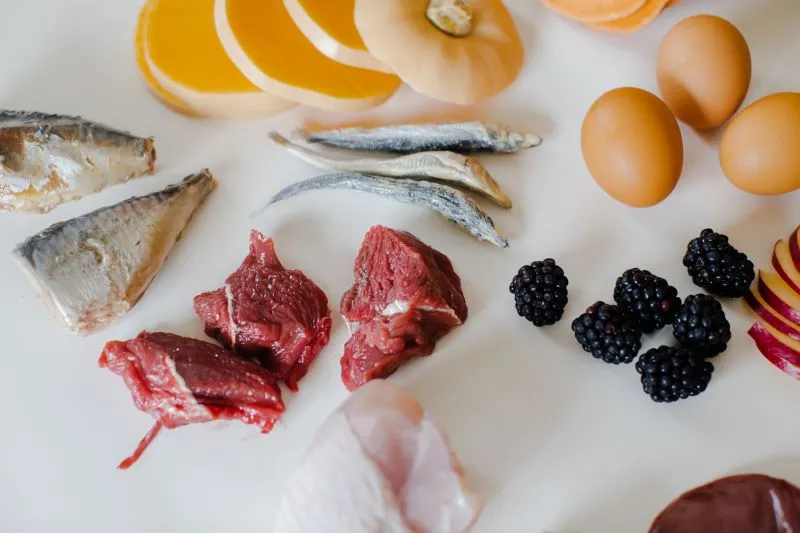Considering a raw food diet for your beloved canine companion can feel overwhelming, with countless questions arising about safety, nutritional balance, and what ingredients are truly beneficial. As passionate dog parents and advocates for optimal pet health, we understand these concerns firsthand. Feeding your dog a raw diet has become an increasingly popular trend among those seeking a more natural and less processed alternative to commercial pet foods. If you’re pondering the switch and asking yourself, “What Can I Feed My Dog On A Raw Diet?” this guide is designed to provide you with clear, stress-free answers, empowering you to make informed decisions for your best friend’s wellbeing.
Embarking on a raw feeding journey is simpler than you might imagine. Forget the notions of extreme complexity, endless hours of preparation, or prohibitive costs. With the right knowledge about suitable ingredients and approximate proportions, preparing your dog’s meals can be just as straightforward as their current routine. Dogs are inherently designed to thrive on raw food, which, when properly prepared, is both safe and incredibly healthy for them. You don’t need gourmet cuts; your pup will flourish on a variety of cost-effective raw options, all contributing to a vibrant, healthy life.
The Undeniable Benefits of a Raw Food Diet for Dogs
Before delving into the specifics of what to feed, it’s essential to understand why a raw diet can be so beneficial for your dog. A raw food diet is inherently natural and unprocessed, meaning it’s free from the artificial flavors, colors, and additives often found in commercial pet foods. This diet comprises ingredients that your dog’s body is naturally equipped to digest, providing a rich source of antioxidants that bolster a strong immune system.
This all-natural approach ensures your dog receives a balanced spectrum of vitamins and minerals vital for their healthiest life. While some perceive risks with raw feeding, thorough research and careful preparation can minimize these concerns significantly, making it a safe and practical choice for many pet owners.
The Essential Role of Raw Meat in a Dog’s Diet
A fundamental question for many starting out is, “Is raw meat good for dogs?” The answer is a resounding yes; raw meat is a natural and crucial component of a dog’s diet. However, it’s vital to understand that a diet composed solely of raw meat will not provide your dog with complete, balanced nutrition.
The appeal of a raw meat diet often stems from its resemblance to the natural diet of a dog’s ancestors – wolves. Despite thousands of years of domestication, dogs share a remarkable 99.8% of their DNA with wolves and possess very similar dietary requirements.
Historically, dogs consumed predominantly raw meat. The shift to processed commercial pet foods, cooked at high temperatures to eliminate bacteria like Salmonella, Listeria, and E. coli, has unfortunately also stripped away many essential nutrients. These nutrients then often need to be artificially supplemented. Therefore, while raw meat is excellent for your dog, their diet must be diversified with other minerals, vitamins, amino and fatty acids, and fiber sources to aid digestion. This holistic approach ensures they receive all necessary elements for optimal health.
 Variety of raw meats, fresh vegetables, and fruits laid out for a balanced dog diet
Variety of raw meats, fresh vegetables, and fruits laid out for a balanced dog diet
This balance can be achieved by incorporating eggs, specific vegetables, and appropriate pet supplements alongside their primary raw meat intake. When considering what you can feed your dog on a raw diet, here are some excellent raw meat options:
Muscle Meats:
- Chicken
- Lamb
- Pork
- Duck
- Rabbit
- Kangaroo
- Beef
- Turkey
- Fish
Organ Meats:
- Kidney
- Liver
- Spleen
- Pancreas
- Brains
Addressing the Risks of Feeding Raw Meat
Concerns about harmful bacteria in raw meat are common, but it’s important to note that parasite contamination is far more prevalent in wild animal carcasses than in commercially sourced raw meat prepared for dogs. To mitigate potential risks, it’s highly recommended to divide raw meat into meal portions and freeze it. Freezing effectively eliminates most bacteria and parasites, if present, without compromising the meat’s nutritional value.
Before feeding, simply defrost the raw meat in the refrigerator overnight. Strict health and safety precautions are paramount when handling raw meat. Always wash your hands thoroughly after handling, and meticulously clean and disinfect all surfaces and objects that come into contact with the meat. These simple steps significantly minimize contamination risks and ensure a safe feeding experience.
 Hands in gloves carefully preparing and portioning raw dog food
Hands in gloves carefully preparing and portioning raw dog food
Integrating Raw Vegetables into Your Dog’s Diet
Many dog owners wonder, “Can dogs eat raw vegetables?” or specifically, “Can dogs have raw carrots?” and “can dogs have raw broccoli?” It’s crucial to remember that a raw diet for dogs extends beyond just meat. Vegetables serve as a vital source of fiber, vitamins, minerals, and antioxidants, all essential components of a balanced raw feeding plan. Plant-based ingredients are instrumental in supporting healthy digestion and fostering a balanced gut microbiome in your dog. In fact, certain vegetables are considered superfoods for dogs!
Vegetables can be offered boiled, steamed, or raw, though they generally retain higher concentrations of nutrients when fed raw. Some dogs will happily munch on raw vegetables as they are, while fussier eaters might benefit from having their veggies chopped or grated into small pieces and mixed with their meat. For more options on what can be fed, you might also find this article helpful: what are dogs allowed to eat.
Best Vegetables for Dogs:
- Carrots
- Celery
- Broccoli
- Brussel sprouts
- Green beans
- Kale
- Peas
- Sweet potato
Including Dog-Friendly Fruits for a Balanced Raw Diet
Fruits are often an overlooked addition to a dog’s diet, with much of the focus typically on protein and vegetables. However, a truly ideal raw food diet for dogs incorporates all three food groups: raw meat, vegetables, and fruit!
Fruits offer numerous health benefits for dogs, including boosting the immune system, reducing inflammation, improving digestion, and promoting healthy skin and coat. However, it’s important to offer fruits in moderation and ensure they are dog-safe. Always remove any pits, seeds, or rinds before serving. If you’re curious about foods dogs should avoid, refer to this useful resource: what are dogs not allowed to eat us.
Best Fruits to Feed Dogs:
- Apples
- Apricots
- Bananas
- Blackberries
- Blueberries
- Cranberries
- Kiwi Fruit
- Mango
- Peaches
- Pears
- Pineapple
- Strawberries
- Watermelon
 A bowl of raw dog food, perfectly portioned and balanced, sits next to a clean water bowl
A bowl of raw dog food, perfectly portioned and balanced, sits next to a clean water bowl
Foods to Absolutely Avoid When Feeding Your Dog a Raw Diet
While fresh vegetables, fruits, and meat are cornerstones of a healthy and balanced raw diet, certain foods are toxic to dogs and must be strictly avoided.
Vegetables to avoid: Avocado, onions, mushrooms, and raw potatoes are all toxic to dogs. Cooked potatoes can be given in very small quantities, but raw is a definite no. For a more detailed look at potentially harmful vegetables, see what vegetables are toxic to dogs.
Fruits to avoid: Unripened tomatoes, cherries, and grapes are highly toxic to dogs and should never be included in their diet. Always conduct thorough research before introducing any new fruit or vegetable to your dog’s meal plan to ensure it’s safe and beneficial.
Popular Raw Feeding Models: BARF vs. Prey Model
While there isn’t one single “best” raw dog food diet, two widely recognized and popular approaches are the BARF diet (Biologically Appropriate Raw Food Diet) and the Prey Model Raw Diet. Both have been established for many years and serve as excellent options for most dogs.
The BARF Diet is designed to provide a comprehensive balance of essential nutrients. Its recommended guidelines typically consist of:
- 70% muscle meat
- 10% raw edible bone
- 7% vegetables
- 5% liver
- 5% other secreting organs
- 2% seeds or nuts
- 1% fruit
The Prey Model Raw Diet appeals to pet parents who prefer a feeding plan that closely mimics the natural diet of a carnivore. Its recommended guidelines are:
- 75-80% muscle meat
- 10% raw edible bone
- 5% liver
- 5% other secreting organs
- 0-5% animal-based fiber
These models offer excellent frameworks for your dog’s raw food meal plan. If these percentages seem daunting at first, many simpler three-step raw dog food plans are available, perfect for beginners, which can help ease you into the routine.
 French Bulldog attentively sitting beside a full bowl of raw dog food
French Bulldog attentively sitting beside a full bowl of raw dog food
Safely Transitioning Your Dog to a Raw Food Diet
Making the switch to a natural raw food diet for your dog is a straightforward process. For most dogs, particularly healthy puppies and young adults, a quick transition can be made overnight. For instance, if they have kibble on Monday, raw food can begin on Tuesday. However, if your dog is a senior, has known allergies, or has been exclusively on a commercial processed diet for a long time, a gradual transition is highly recommended to prevent any stomach upset. A sudden dietary change might shock a gut accustomed only to processed foods.
The best approach for these sensitive dogs is to gradually wean them off their current food over approximately 7 to 14 days. The exact duration depends on their age and overall health. Here’s an easy daily guide for how to start your dog on raw food as a beginner:
- DAY 1-3: 20% raw food, 80% current food
- DAY 4-6: 40% raw food, 60% current food
- DAY 7-9: 60% raw food, 40% current food
- DAY 10-12: 80% raw food, 20% current food
- DAY 12+: 100% raw food
This is a flexible guide; you don’t need to adhere to the percentages strictly. The primary goal is to slowly increase their raw food intake over a week or two until they are fully on a raw diet.
Determining How Much Raw Food to Feed Your Dog
Accurately determining the daily amount of raw food for your dog is crucial and is primarily calculated based on their body weight. Generally, a dog should consume 2-5% of their body weight in raw food daily. Where your dog falls within this range will depend on individual factors such as their weight, overall health, and activity levels. Active dogs, for example, may require a higher percentage. If you’re unsure about feeding specific human foods to younger dogs during this transition, consider consulting our guide on what human food can you give a puppy.
For those preparing meals from scratch, many online raw dog food feeding guides and calculators exist. These tools allow you to input your dog’s age, weight, and activity levels to precisely calculate their daily raw food requirements, taking the guesswork out of meal planning.
 A happy dog curiously observing a display of fresh raw food ingredients
A happy dog curiously observing a display of fresh raw food ingredients
Smart Tips to Save on the Cost of a Raw Food Diet for Dogs
One common misconception is that feeding a raw diet is prohibitively expensive. With a few smart strategies, you can make raw feeding cost-effective:
- Bulk Buying and Freezing: If you plan to prepare raw meat yourself, buying in bulk, portioning, and then freezing can save both time and money. Shaping portions into balls or patties can make storage and thawing easier.
- Find a Local Butcher: Establishing a relationship with a good local butcher can be invaluable. Explain that you’re preparing a raw meal plan for your dog and ask for cost-effective items like cheaper cuts, raw meaty bones, chicken wings or backs, and offal (heart, kidneys, liver), or lean mince and scraps.
- Utilize Sales: Keep an eye out for sales on dog-safe meats and vegetables at your local grocery store or butcher.
 An array of raw ingredients, including various meats, fish, eggs, and fruits, prepared for a dog's meal
An array of raw ingredients, including various meats, fish, eggs, and fruits, prepared for a dog's meal
Embarking on a raw diet for your dog is a rewarding journey towards a healthier, happier life for your best friend. By understanding what you can feed your dog on a raw diet and adhering to safe preparation and transition practices, you’re providing them with the natural nutrition they deserve. For any concerns about digestive issues during the transition, consider reviewing information on what food to give your dog with an upset stomach.
References
- ‘What You Need to Know About Raw Food Diets for Dogs’: https://www.petmd.com/dog/nutrition/5-mistakes-people-make-when-feeding-pets-raw-food-diet
- ‘Raw Feeding Factsheet’: https://www.pfma.org.uk/raw-feeding-factsheet
- ‘Current knowledge about the risks and benefits of raw meat-based diets for dogs and cats’: https://pubmed.ncbi.nlm.nih.gov/24261804/
- ‘Nutrition and health of dogs and cats: evolution of pet food’:https://pubmed.ncbi.nlm.nih.gov/16244924/
